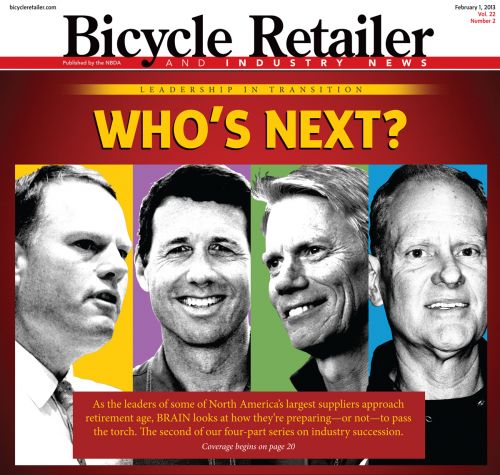Editor's note: The following article is part of BRAIN's ongoing series on generational change in the bike industry. Read more.
By Nicole Formosa
CHICAGO, IL (BRAIN) — Succession first hit Stan Day’s radar around the early 2000s when a SRAM board member brought up the word in a meeting. At that point, and even today, Day, the CEO, president and chairman of the board of the components company he helped start in 1987, wasn’t accustomed to thinking so long term.
“I’ve always been on a rolling five-year horizon,” he said. “I’ll be doing something else (at SRAM) in five years; it’s always been that next five-year period.”
Shortly after that first mention, SRAM’s senior management group began discussing the topic quarterly. They listed the names of potential candidates within the organization who could potentially rise to the top, and the list is reviewed every three months.
“Sometimes it’s an awkward situation because you have to make choices,” the 54-year-old Day said. “You kind of have to express opinions about people you work with.”
But even after more than a decade of discussions, Day still doesn’t know who will become the next president of SRAM when he transitions out of his leadership role, a prospect that is still on the distant horizon. “It’s not something I can see,” he said.
One of the biggest issues Day has experienced in planning for succession—and one to which many leaders in the industry can likely relate—is the difficulty in rotating high-level managers into jobs outside their departments so they can gain that cross-functional knowledge that is ideal for the future president to have. For instance, the head of engineering could not leave that post for three years to study the sales side because SRAM doesn’t have the bandwidth to backfill the role.
Another wild card for SRAM concerns if and when it decides to issue an initial public offering on the Nasdaq stock exchange, plans for which the company first announced nearly two years ago. If it does go public—a move Day said the company is still evaluating—its next president will need to be comfortable with, and capable of, running a public company. He also envisions the next leader as someone who has come up through the organization, with a good understanding of the industry and trust of the company and the senior management group.
“We have to see how it all evolves, but I think we’re in an unusual industry. We’re a relatively small industry, but it’s spread around the world. There are a lot of moving parts, and there are not a lot of examples of people coming into the industry and learning it,” Day said.
Day is confident that the tone set by SRAM’s founders and longtime executives placing value on taking risks, working hard and developing innovative products is one that will continue well past the retirement of the founding generation. Other members of the executive management team include chief financial officer Michael Herr, who is still in his mid-40s; chief operating officer Jeff Shupe, in his late 40s; and F.K. Day, Stan Day’s younger brother and the company’s executive vice president, a board member and president of World Bicycle Relief, SRAM’s nonprofit foundation.
“I think that as we evolve out of the organization, ultimately we choose leaders who are respectful of what has been built over time, and it will be relatively easy for them to sustain the culture. Practically speaking, multiple generations down the road, we hope the organization continues to evolve and perform,” he said.
Even after he’s stepped away from the daily tasks of steering the direction of the $500 million-plus company, Day has no intention of disappearing. He is likely to remain chairman of the board of directors and the Day family will maintain voting control over the company even if it does go public. Along with the Day brothers, several other family members are also shareholders. A potential IPO would be split into two classes of stock so that the family maintains voting control until its ownership drops below 15 percent, ensuring its leadership values stay intact. Day said the family intends on remaining owners of SRAM for the long haul.
“Until we found somebody that was a better owner — and I don’t know when and if we’d ever find that — we feel a responsibility to the organization, to the industry that we keep doing what we’re doing,” he said.


